 “Don’t follow trends, start trends” was the lesson Frank Capra instilled upon us all when he accepted the AFI Lifetime Achievement Award in 1982. While other filmmakers of his day were unspooling mindless musicals, burlesque comedy and gangland shoot em’ ups, Mr. Capra was making films focused on his undying faith in the uplifting of the human condition by highlighting the actions one individual can make upon the community. Mr. Deeds Goes to Town, Meet John Doe, Mr. Smith Goes to Washington and my favorite, It’s A Wonderful Life all illustrate the conflict of the Good Man in Society v. Evil Man in Society, with the outcome teetering on the precipice of self-doubt, even death. Capra’s heroes were pitted in a David & Goliath battle. David gets KO’d on his feet taking a bloody whooping’, but with the enduring support of his fellow man, he’s pushed back into the ring where he grits his teeth and lands a Rocky-like punch that stupefies Goliath to the mat for the 10 count. So it was with the making of The Venice Walk, 1 needed support from my fellow man.
“Don’t follow trends, start trends” was the lesson Frank Capra instilled upon us all when he accepted the AFI Lifetime Achievement Award in 1982. While other filmmakers of his day were unspooling mindless musicals, burlesque comedy and gangland shoot em’ ups, Mr. Capra was making films focused on his undying faith in the uplifting of the human condition by highlighting the actions one individual can make upon the community. Mr. Deeds Goes to Town, Meet John Doe, Mr. Smith Goes to Washington and my favorite, It’s A Wonderful Life all illustrate the conflict of the Good Man in Society v. Evil Man in Society, with the outcome teetering on the precipice of self-doubt, even death. Capra’s heroes were pitted in a David & Goliath battle. David gets KO’d on his feet taking a bloody whooping’, but with the enduring support of his fellow man, he’s pushed back into the ring where he grits his teeth and lands a Rocky-like punch that stupefies Goliath to the mat for the 10 count. So it was with the making of The Venice Walk, 1 needed support from my fellow man.
1 call The Venice Walk a “Federally Funded Project”, because 1 made it with the seven thousand dollars of unemployment money paid to me from teaching high school, and my Welcome Back, Kotter residuals. That covered equipment rental, tape stock, pizza, coffee and donuts, gas and parking to the cast and crew, stationary supplies, location tips (not fees, tips for locations to open after hours), etc. Joey Paul, the Hollywood casting directory at Disney/Touchstone had rejected me for about 6 auditions for Disney projects. 1 need to cast my young juvenile delinquents so… 1 called Joey. She read the scri pt and without hesitation said she was in. When 1 explained 1 had no money to pay her for her services, she said not to worry, it was a worthy project that made a statement about today’s youth, and 1 could compensate her when 1 sold it. Deferred payment.
unemployment money paid to me from teaching high school, and my Welcome Back, Kotter residuals. That covered equipment rental, tape stock, pizza, coffee and donuts, gas and parking to the cast and crew, stationary supplies, location tips (not fees, tips for locations to open after hours), etc. Joey Paul, the Hollywood casting directory at Disney/Touchstone had rejected me for about 6 auditions for Disney projects. 1 need to cast my young juvenile delinquents so… 1 called Joey. She read the scri pt and without hesitation said she was in. When 1 explained 1 had no money to pay her for her services, she said not to worry, it was a worthy project that made a statement about today’s youth, and 1 could compensate her when 1 sold it. Deferred payment.
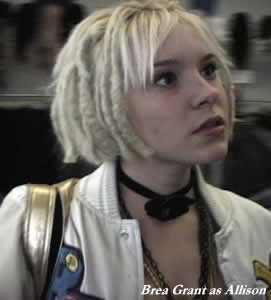 Casting was a dream, for Joey sorted out the nearly 2000 submissions for the seven teenager roles down to a few hundred. My old friend Bret Hudson, (one of the famed Hudson Brothers) came on board loaning me his lighting package, two digital cameras with boom mikes, a Final Cut editing bay, and a box of duct tape. Wow… 1 got a camera department. Now 1 was able to hold screen tests, and 1 began shooting B Roll all over Venice. (annoyed Merchants called me “Bowfinger”) 6 hours worth of B Roll that 1 catalogued on Word, shot by shot (time code was malfunctioning the camera). Over 2000 shots. Andrea McDonald, a young tattooed Venetian by way of a brief run at Parsons in Manhattan, heeded my pleas for an assistant (now associate producer) for the production, and did everything from operate cameras, to make up crew and actor calls, to set-up character MySpace Profiles, to boom sound, to crowd and traffic control (try traffic control with no permits on Abbott Kinney Blvd.) ran the production.
Casting was a dream, for Joey sorted out the nearly 2000 submissions for the seven teenager roles down to a few hundred. My old friend Bret Hudson, (one of the famed Hudson Brothers) came on board loaning me his lighting package, two digital cameras with boom mikes, a Final Cut editing bay, and a box of duct tape. Wow… 1 got a camera department. Now 1 was able to hold screen tests, and 1 began shooting B Roll all over Venice. (annoyed Merchants called me “Bowfinger”) 6 hours worth of B Roll that 1 catalogued on Word, shot by shot (time code was malfunctioning the camera). Over 2000 shots. Andrea McDonald, a young tattooed Venetian by way of a brief run at Parsons in Manhattan, heeded my pleas for an assistant (now associate producer) for the production, and did everything from operate cameras, to make up crew and actor calls, to set-up character MySpace Profiles, to boom sound, to crowd and traffic control (try traffic control with no permits on Abbott Kinney Blvd.) ran the production.
The cast was assembled with the understanding that there was no pay, but they would get footage for their reel (yet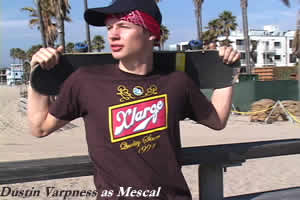 to do that, sorry kids) and play the roles once we were picked up for production. The Bard said “the plays the thing”, but 1 felt that the Actors “made it sing”. Their auditions were part text, part unannounced improvisation. The winners never left character, got where 1 was taking them, and crushed the material and the “jam session”. 1 always felt like 1 was putting together an orchestra… and jazz band, if you will, and 1 wanted players who could wail when the solo came their way, and they did. Priscilla Medina, Riche Blair, Brittny Stewart, Dustin Varpness, Preston Davis, Brea Grant, Garret Plotkin and Tiffany Moretti are all unknowns, never given a shot at the “Big Show”. They will all eventually be known as “The Brat Pack” of Internet Video Universe. They are that sharp!
to do that, sorry kids) and play the roles once we were picked up for production. The Bard said “the plays the thing”, but 1 felt that the Actors “made it sing”. Their auditions were part text, part unannounced improvisation. The winners never left character, got where 1 was taking them, and crushed the material and the “jam session”. 1 always felt like 1 was putting together an orchestra… and jazz band, if you will, and 1 wanted players who could wail when the solo came their way, and they did. Priscilla Medina, Riche Blair, Brittny Stewart, Dustin Varpness, Preston Davis, Brea Grant, Garret Plotkin and Tiffany Moretti are all unknowns, never given a shot at the “Big Show”. They will all eventually be known as “The Brat Pack” of Internet Video Universe. They are that sharp!
Craig Titley, my creative partner arrived on a “White Horse”. Craig and 1 got together from a mutual friend, Producer Warren Zide (Final Destination, American Pie). Warren had optioned my Marx Brothers screenplay, and thought we should work together. Craig and 1 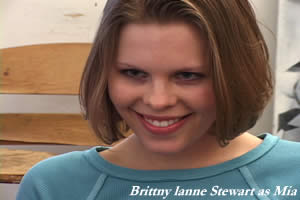 traded scri pts (1 have nine unproduced) and when he read, The Venice Walk, then The Big Apple, he said, he wanted to develop that with me. Now Craig is a real A list screen writer, he just finished writing the remake of 20 Thousand Leagues Under the Sea for Sam Raimi at New Line, a USC Film School undergrad, Fellow, and now writing his dissertation for his PhD on Joseph Campbell. When Craig made a suggestion, 1 took it. When Craig wanted to delete or add another character, 1 did it. When Craig said, “let’s have lunch”, he always paid. Craig made The Venice Walk better by me always being willing to take his notes and implement them without hesitation. 1 always feel that when 1’m the smartest guy in the room, 1’m in trouble. Working with Craig in a room always took care of that fear.
traded scri pts (1 have nine unproduced) and when he read, The Venice Walk, then The Big Apple, he said, he wanted to develop that with me. Now Craig is a real A list screen writer, he just finished writing the remake of 20 Thousand Leagues Under the Sea for Sam Raimi at New Line, a USC Film School undergrad, Fellow, and now writing his dissertation for his PhD on Joseph Campbell. When Craig made a suggestion, 1 took it. When Craig wanted to delete or add another character, 1 did it. When Craig said, “let’s have lunch”, he always paid. Craig made The Venice Walk better by me always being willing to take his notes and implement them without hesitation. 1 always feel that when 1’m the smartest guy in the room, 1’m in trouble. Working with Craig in a room always took care of that fear.
Okay, the team was almost in place except for the single most important player who had to work “pro bono,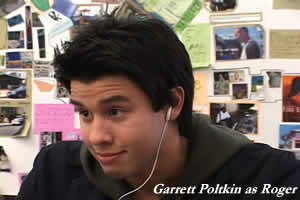 gratis, deferred”… in other words, for free. Michael Nallin came my way when 1 was simultaneously prepping The Venice Walk and researching and then directing the interviews for the DVD release of Welcome Back, Kotter for Warner Brothers. My producer for the DVD’s suggested Mike when 1 explained that 1 needed someone who could string together the 40 minute pilot, then turn them into 6 minute mini—webisodes for the web site and mobile content providers. Michael had spent years at Universal and Paramount cutting trailers. He was a go to guy to tell a 90-minute story in two minutes. Perfection! Michael was concerned about the salary compensation, (or lack of) until he read the scri pt, then he said that not only would he edit, he’d operate cameras too. (1 was operating when 1 wasn’t acting in a scene)
gratis, deferred”… in other words, for free. Michael Nallin came my way when 1 was simultaneously prepping The Venice Walk and researching and then directing the interviews for the DVD release of Welcome Back, Kotter for Warner Brothers. My producer for the DVD’s suggested Mike when 1 explained that 1 needed someone who could string together the 40 minute pilot, then turn them into 6 minute mini—webisodes for the web site and mobile content providers. Michael had spent years at Universal and Paramount cutting trailers. He was a go to guy to tell a 90-minute story in two minutes. Perfection! Michael was concerned about the salary compensation, (or lack of) until he read the scri pt, then he said that not only would he edit, he’d operate cameras too. (1 was operating when 1 wasn’t acting in a scene) 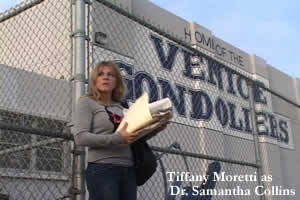 He hadn’t worked for free since undergrad at Penn State Film School, but for a piece of the action, and no executive in a suit looking over his shoulder, he was in for the long haul… What is on screen today, what makes The Venice Walk, a worthy piece of cinema, is because Michael Nallin believed in the project and edited it beautifully,
He hadn’t worked for free since undergrad at Penn State Film School, but for a piece of the action, and no executive in a suit looking over his shoulder, he was in for the long haul… What is on screen today, what makes The Venice Walk, a worthy piece of cinema, is because Michael Nallin believed in the project and edited it beautifully,
Finally, ready to shoot. 1’m up to two packs a day and a gallon of coffee between the Kotter DVD and prepping The Venice Walk. But like 1 said, 1 was having the most fun 1 ever had with my clothes on. 1 was ready to roll. Friday November 17th, 6:30 am. 20 set-ups today. Three locations. 1 awaken with a sharp knife-like pain under my left scapula. Maybe 1 slept on it wrong and laid back down, but it got worse. 1 went to stand up, 1 was dizzy, sweating, nauseous. Now the pain was going into my left arm… then finally, from my neck up into my temple. My brother is an emergency room doc. We had talked about this symptom once when he was telling me about an ER patient who died on him. 1 feel back into bed, stunned. “ Jesus Christ… 1’m having a fucking heart attack!”

